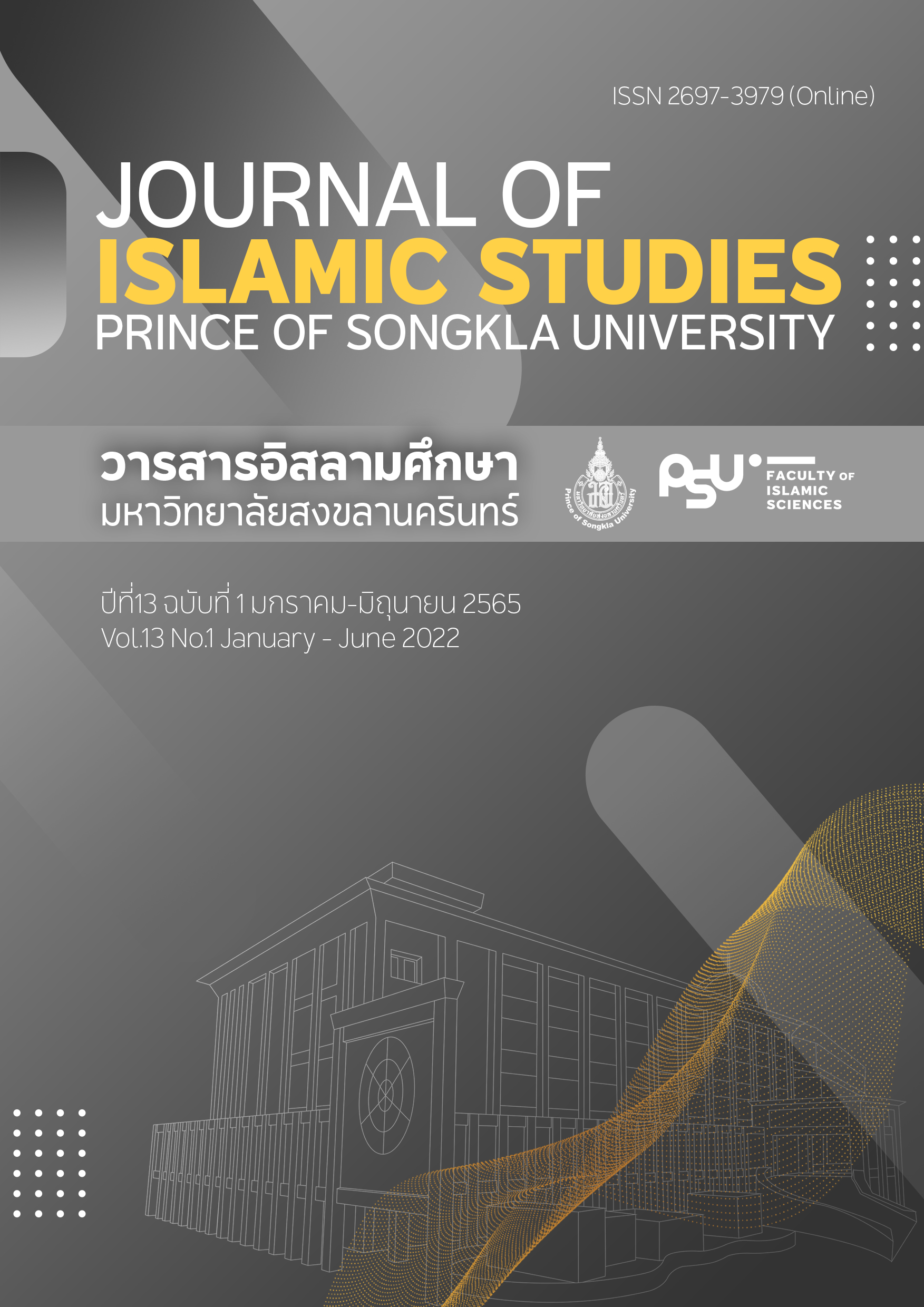อัลวะสะฏียฺยะฮฺ (แนวทางสายกลาง) ตามการรับรู้ของนักศึกษาคณะวิทยาการอิสลาม มหาวิทยาลัยสงขลานครินทร์
คำสำคัญ:
การรับรู้, อัลวะสะฏียยะฮ์, นักศึกษาคณะวิทยาการอิสลามบทคัดย่อ
จุดประสงค์ เพื่อศึกษาการรับรู้ของนักศึกษาคณะวิทยาการอิสลาม มหาวิทยาลัย สงขลานครินทร์ ที่มีต่อหลักอัลวะสะฏียยะฮ์ตามองค์ประกอบ 4 ด้าน ได้แก่ อะกีดะฮ์ (ความเชื่อ) อิบาดะฮ์ (การปฏิบัติศาสนกิจ) อัคลากฺ (จริยธรรม) และมุอามะลาต (การปฏิสัมพันธ์)
วิธีการศึกษา งานวิจัยนี้ใช้วิธีการวิจัยเชิงสำรวจ เก็บรวบรวมข้อมูลด้วยแบบสอบถามจากกลุ่มตัวอย่าง จำนวน 241 คน และวิเคราะห์ข้อมูลโดยใช้สถิติเชิงพรรณนา ได้แก่ ค่าความถี่และค่าร้อยละ และสถิติไคร์สแควร์
ผลการศึกษา ผลการวิจัยพบว่า นักศึกษามีการรับรู้ต่อหลักอัลวะสะฏียยะฮ์ทุกด้านอยู่ในระดับมาก ประเด็นความคลาดเคลื่อนในการรับรู้ที่สำคัญคือ มีความเชื่อว่าระหว่างอิสลามและศาสนาอื่นมีความถูกต้องเหมือนกัน การอบรมไม่มีความสัมพันธ์กับการรับรู้ และผู้ที่ไม่ลงทะเบียนเรียนกลับมีการรับรู้ที่คลาดเคลื่อนน้อยกว่าข้อค้นพบนี้สามารถนำไปใช้เป็นแนวทางในการพัฒนานักศึกษาในการดำเนินชีวิตตามแนวทางสายกลางในสังคมพหุวัฒนธรรม
การนำผลการวิจัยไปใช้ หน่วยงานและบุคลากรที่เกี่ยวข้องกับการดูแลนักศึกษาสามารถที่จะใช้ผลการวิจัยนี้เป็นแนวทางในการเรียนรู้ถึงแนวคิดและปรัชญาพื้นฐานขององค์ประกอบอัลวะสะฏียยะฮ์ที่เหมาะสมในบริบทของนักศึกษาระดับอุดมศึกษา เพื่อที่จะสามารถนำไปประยุกต์ใช้ในการปรับพฤติกรรมของนักศึกษาให้อยู่ในวิถีของผู้ปฏิบัติตนตามแนวทางสายกลาง
เอกสารอ้างอิง
‘Abdullah Bin ‘Abd al-Azīz al-Yahyā. (2008). al-Wasatiyyah al-Tarīq Ilā al-Ghad. Dar Kunūz Ishbiliya Li al-Nashar Wa al-Tauzī’a
‘Abd al-Rahman ‘Abd al-Azīz al-Sudais. (2017). Bulūgh al-Aāmāl Fī Tahqīq al-Wasatiyyah Wa al-I’tidāl.Maktabah al-Malik Fahad al-Wataniyyah Athna al-Nashar, Mamlakah al-Arabiyyah al-Saūdiyyah
’Ahmad Shalabī. (1982). al-Tarbiyyat al-’Islāmiyyah Nuzumuhā – Falsafatuhā –Tarīkhuhā Maktabat al-Nahdah al-Misriyah
al- ‘Asqalānī, ’Ahmad Bin ‘Ali Bin Hฺajar. (1989). Fathu al-Bāri Sharh Sahīh al-Bukhāriy. Dār al-Kutub al-‘Ilmiyyah
‘Alī Muhammad Muhammad al-Sallābī. (2001). al-Wasatiyah Fī al-Qur’ān al-Karīm. Maktabah al-Sahabah
Alumni Arab Students Association of Thailand. (n.d.). The Holy al-Qur’ān with Thai Translation. (Al-Madinah al-Munawwarah): King Fahd Centre for the Printing of the Holy al-Qur’ān.
Alhusain, I. (2018). Gaan tam kwaam kâo jai làk al wá sa tiy yá láe gaan nam bpai chái nai chee-wít jing. Al-Nur Journal of Graduate School, Fatoni University, 13 (25), 203-222.
Katih, I. (2018). Wasatiyah in Islam and Living in Multicultural Society, Base on Belief and Concept. Journal of Islamic Studies, Prince of Songkla University, 9(1), 32-48.
Japakiya, I.L. (2015). Ummatan Wasata [Online]. Retrieved May 26, 2021, from: http://d1.islamhouse.com>ih_books/single/th_ummah_ wasata_withi_khara_ummah.docx
Muhammad Bā Karīm Muhammad Bā ‘Abdullah. (1994). Wasatiyyah Ahl al-Sunnah Bain al-Firaq. Kulliyah al-Da’wah Wa Usūl al-Dīn, Jāmi’ah al-Islāmiyyah Bi al-Madīnah al-Munawwarah. Dār al-Rāyah : Mamlakah al-Arabiyyah al-Saūdiyyah
I’sām Sālih Ahmad Rājih. (2016). al-Wasatiyah Wa Mazāhiruha Fī al-Qur’ān al-Karīm (Dirāsah Maudūiyyah). Kulliyah al-Dirāsat al-Ulyā, Dāirah al-Qur’ān al-Karīm Wa Ulūmih, Shu’bah al-Tafsīr Wa Ulūmih.
Al-Shaikh ‘Abd al-Rahman Hasan Habankah al-Maidāni. (1996). al-Wasatiyah Fī al-Islām. Mu’assasah al-Raiyān
Yūsuf al-Qaradāwī. (2012). Fiqh al-Wasatiyat al-Islāmiyah Wa al-Tajdīd. Dar al-Shuruq
ดาวน์โหลด
เผยแพร่แล้ว
รูปแบบการอ้างอิง
ฉบับ
ประเภทบทความ
สัญญาอนุญาต
ลิขสิทธิ์ (c) 2022 วารสารอิสลามศึกษา มหาวิทยาลัยสงขลานครินทร์

อนุญาตภายใต้เงื่อนไข Creative Commons Attribution-NonCommercial-NoDerivatives 4.0 International License.
บทความทุกเรื่อง ที่ได้รับการตีพิมพ์ในวารสารอิสลามศึกษาเป็นแนวคิดของผู้เขียน มิใช่เป็นความคิดเห็นคณะผู้จัดทำและมิใช่ความรับผิดชอบของคณะวิทยาการอิสลาม กองบรรณาธิการไม่สงวนสิทธิ์การคัดลอก แต่ให้มีการอ้างอิงแสดงที่มา




